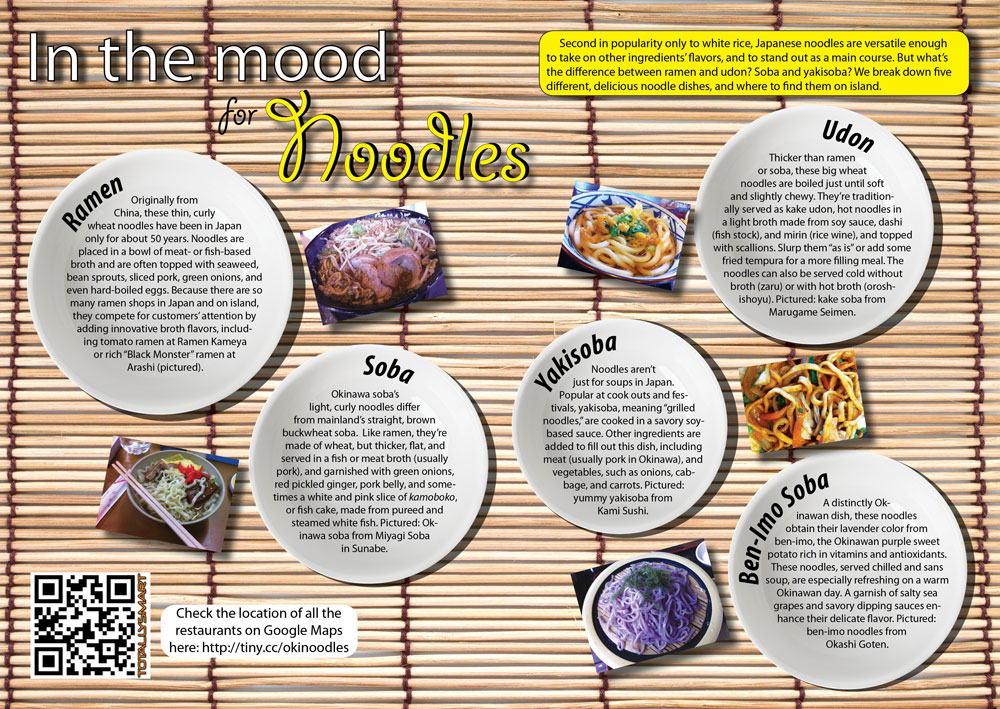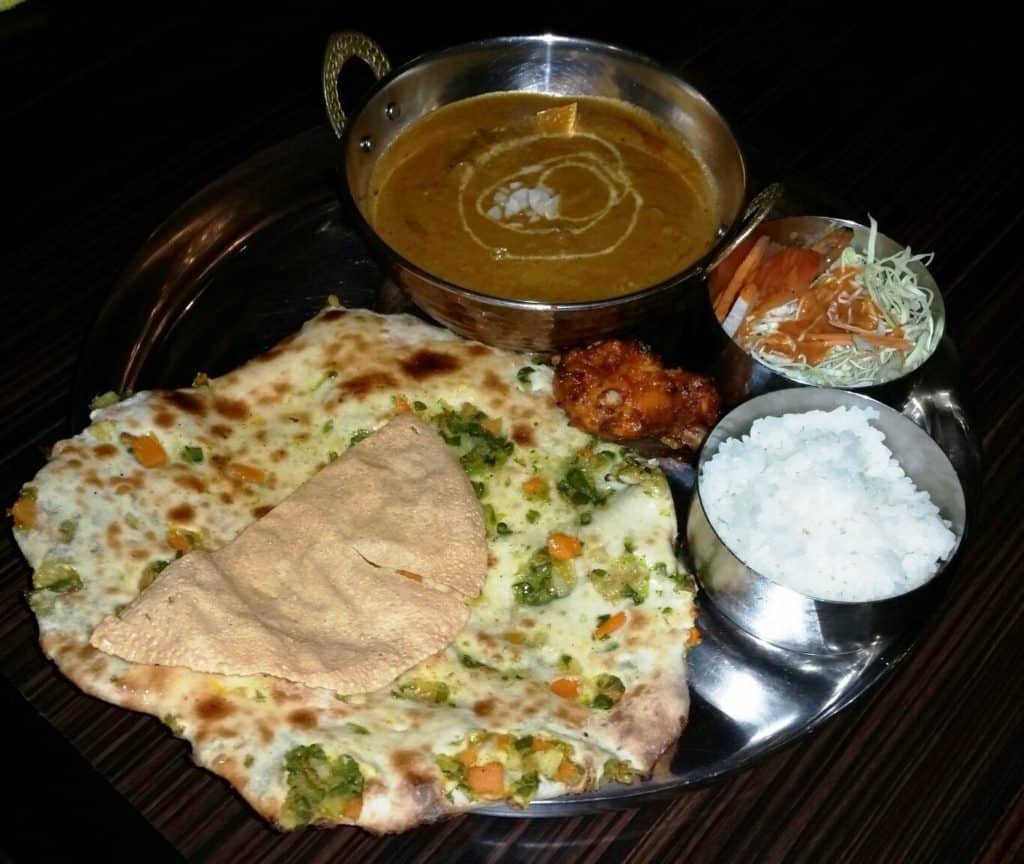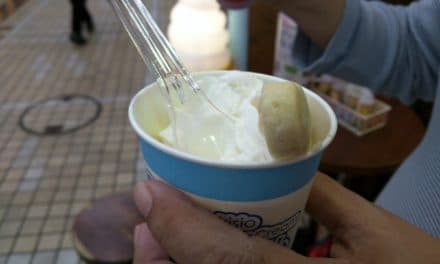Second in popularity only to white rice, Japanese noodles are versatile enough to take on other ingredients’ flavors, and to stand out as a main course. But what’s the difference between ramen and udon? Soba and yakisoba? We break down five different, delicious noodle dishes, and where to find them on island.
Ramen
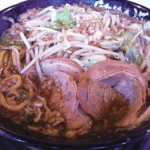 Originally from China, these thin, curly wheat noodles have been in Japan only for about 50 years. Noodles are placed in a bowl of meat- or fish-based broth and are often topped with seaweed, bean sprouts, sliced pork, green onions, and even hard-boiled eggs. Because there are so many ramen shops in Japan and on island, they compete for customers’ attention by adding innovative broth flavors, including tomato ramen at Ramen Kameya or rich “Black Monster” ramen at Arashi (pictured). Google Map
Originally from China, these thin, curly wheat noodles have been in Japan only for about 50 years. Noodles are placed in a bowl of meat- or fish-based broth and are often topped with seaweed, bean sprouts, sliced pork, green onions, and even hard-boiled eggs. Because there are so many ramen shops in Japan and on island, they compete for customers’ attention by adding innovative broth flavors, including tomato ramen at Ramen Kameya or rich “Black Monster” ramen at Arashi (pictured). Google Map
Soba
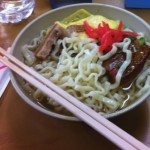 Okinawa soba’s light, curly noodles differ from mainland’s straight, brown buckwheat soba. Like ramen, they’re made of wheat, but thicker, flat, and served in a fish or meat broth (usually pork), and garnished with green onions, red pickled ginger, pork belly, and sometimes a white and pink slice of kamoboko, or fish cake, made from pureed and steamed white fish. Pictured: Okinawa soba from Miyagi Soba in Sunabe. Google Map
Okinawa soba’s light, curly noodles differ from mainland’s straight, brown buckwheat soba. Like ramen, they’re made of wheat, but thicker, flat, and served in a fish or meat broth (usually pork), and garnished with green onions, red pickled ginger, pork belly, and sometimes a white and pink slice of kamoboko, or fish cake, made from pureed and steamed white fish. Pictured: Okinawa soba from Miyagi Soba in Sunabe. Google Map
Yakisoba
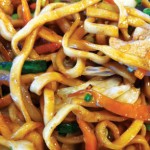 Noodles aren’t just for soups in Japan. Popular at cook outs and festivals, yakisoba, meaning “grilled noodles,” are cooked in a savory soy-based sauce. Other ingredients are added to fill out this dish, including meat (usually pork in Okinawa), and vegetables, such as onions, cabbage, and carrots. Pictured: yummy yakisoba from Kami Sushi. Google Map
Noodles aren’t just for soups in Japan. Popular at cook outs and festivals, yakisoba, meaning “grilled noodles,” are cooked in a savory soy-based sauce. Other ingredients are added to fill out this dish, including meat (usually pork in Okinawa), and vegetables, such as onions, cabbage, and carrots. Pictured: yummy yakisoba from Kami Sushi. Google Map
Udon
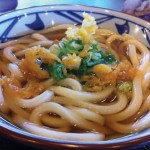 Thicker than ramen or soba, these big wheat noodles are boiled just until soft and slightly chewy. They’re traditionally served as kake udon, hot noodles in a light broth made from soy sauce, dashi (fish stock), and mirin (rice wine), and topped with scallions. Slurp them “as is” or add some fried tempura for a more filling meal. The noodles can also be served cold without broth (zaru) or with hot broth (oroshishoyu). Pictured: kake soba from Marugame Seimen. Google Map
Thicker than ramen or soba, these big wheat noodles are boiled just until soft and slightly chewy. They’re traditionally served as kake udon, hot noodles in a light broth made from soy sauce, dashi (fish stock), and mirin (rice wine), and topped with scallions. Slurp them “as is” or add some fried tempura for a more filling meal. The noodles can also be served cold without broth (zaru) or with hot broth (oroshishoyu). Pictured: kake soba from Marugame Seimen. Google Map
Ben-Imo Soba
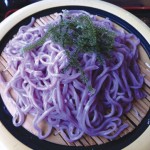 A distinctly Okinawan dish, these noodles obtain their lavender color from ben-imo, the Okinawan purple sweet potato rich in vitamins and antioxidants. These noodles, served chilled and sans soup, are especially refreshing on a warm Okinawan day. A garnish of salty sea grapes and savory dipping sauces enhance their delicate flavor. Pictured: ben-imo noodles from Okashi Goten. Google Map
A distinctly Okinawan dish, these noodles obtain their lavender color from ben-imo, the Okinawan purple sweet potato rich in vitamins and antioxidants. These noodles, served chilled and sans soup, are especially refreshing on a warm Okinawan day. A garnish of salty sea grapes and savory dipping sauces enhance their delicate flavor. Pictured: ben-imo noodles from Okashi Goten. Google Map
![]()

